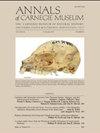Two New Species of Small-Eared Shrews of the Genus Cryptotis Pomel, 1848, from the Colombian Andes (Mammalia: Eulipotyphla: Soricidae)
IF 0.9
4区 地球科学
Q4 PALEONTOLOGY
引用次数: 0
Abstract
ABSTRACT Shrews (Mammalia: Eulipotyphla: Soricidae) reach the southern limit of their New World distribution in the Andes and eastern coastal highlands of northern South America. South of Honduras, the family is represented only by species of the genus Cryptotis Pomel, 1848. In South America, soricids are restricted to moist, high-elevation environments above 1000 m, and their distribution appears to be discontinuous. Study of specimens from a previous gap in the known geographical range of shrews in the Central Cordillera of southwestern Colombia reveals the presence of two unique populations that are distinguishable from each other and their congeners by a combination of morphological and morphometrical characters. They are described herein as, Cryptotis huttereri, n. sp. and Cryptotis andinus, n. sp. Both species are members of the Cryptotis thomasi group, one of five species groups of small-eared shrews defined partly on the basis of postcranial morphology and potential locomotor behavior. Although species in the C. thomasi group share similar postcranial architecture, as exemplified by the morphology of the forelimb, the group appears to be polyphyletic, implying convergence in locomotor behavior, possibly one uniquely adapted for Andean-type montane habitats. Recognition of C. huttereri and C. andinus brings the total number of known South American soricids to 19 species, with 11 species occurring in Colombia. Of those, seven species are endemic to that country.来自哥伦比亚安第斯山脉的两种新的小耳鼩属 Cryptotis Pomel, 1848 (哺乳纲: Eulipotyphla: Soricidae)
摘要鼩鼱(哺乳纲:Eulipotyphla:Soricidae)在南美洲北部安第斯山脉和东部沿海高地达到了新大陆分布的南部极限。在洪都拉斯以南,该科仅有 Cryptotis Pomel 属(1848 年)的物种。在南美洲,鞘翅目昆虫仅限于海拔 1000 米以上的潮湿高海拔环境,其分布似乎是不连续的。通过对哥伦比亚西南部中科迪勒拉山系鼩鼱已知地理分布范围中的一个空白区域的标本进行研究,发现了两个独特的种群,通过形态和形态计量学特征的综合分析,这两个种群可以彼此区分开来,也可以与它们的同系种群区分开来。这两个物种都是Cryptotis thomasi群的成员,该群是小耳鼩鼱的五个物种群之一,部分是根据颅后形态和潜在的运动行为来定义的。尽管C. thomasi组中的物种具有相似的颅后结构,例如前肢的形态,但该组似乎是多单系的,这意味着它们的运动行为趋同,可能是一种独特的适应安第斯型山地栖息地的运动行为。C.huttereri和C.andinus的发现使已知的南美洲鞘翅目昆虫总数达到19种,其中11种分布于哥伦比亚。其中,7 个物种为该国特有。
本文章由计算机程序翻译,如有差异,请以英文原文为准。
求助全文
约1分钟内获得全文
求助全文
来源期刊

Annals of Carnegie Museum
综合性期刊-动物学
CiteScore
2.50
自引率
18.20%
发文量
4
审稿时长
>12 weeks
期刊介绍:
Annals of Carnegie Museum is a quarterly journal that publishes peer-reviewed short and medium-length original scientific contributions in organismal biology, earth sciences, and anthropology, in 40 by 52.5 pica format (168 by 220 mm or 6-5/8 by 8-5/8 inches). Subject matter must be relevant to Carnegie Museum of Natural History scientific sections or Powdermill Nature Reserve (PNR), preferably with connection to the Carnegie collection and/or personnel. Carnegie Museum staff and research associates receive publication priority, but others are encouraged to submit papers, especially those manuscripts explicitly based on the Carnegie collection.
 求助内容:
求助内容: 应助结果提醒方式:
应助结果提醒方式:


